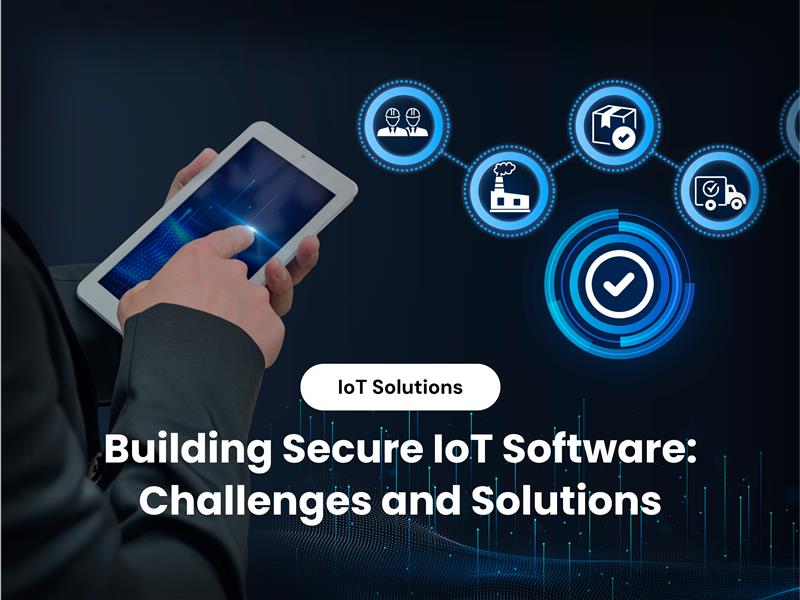
Building Secure IoT Software Challenges and Solutions
The Internet of Things (IoT) has revolutionized how we interact with technology, enabling seamless connectivity between devices and applications. However, as IoT adoption continues to grow, the need for secure IoT software becomes increasingly urgent. This blog explores the challenges in IoT software development and offers solutions to ensure data protection, address IoT vulnerabilities, and establish secure device connectivity.
The Importance of Secure IoT Software
Secure IoT software is the backbone of reliable and trustworthy IoT systems. Without robust security measures, IoT devices are exposed to potential threats, including data breaches, unauthorized access, and system failures. Ensuring security in IoT software protects sensitive data and maintains the integrity of connected devices, fostering user trust and enabling the continued growth of IoT ecosystems.
Key Challenges in IoT Software Development
The rapid growth of the Internet of Things (IoT) has introduced new complexities and challenges in developing secure and reliable software. Addressing these challenges is essential to ensure the safety, functionality, and scalability of IoT ecosystems. Below are the key challenges faced in IoT software development:
IoT Security Risks
IoT devices often operate in physically unsecured environments, exposing them to risks such as tampering and unauthorized access. This vulnerability is compounded by cyberattacks like Distributed Denial of Service (DDoS) attacks and ransomware, which target IoT networks by exploiting outdated or poorly secured software. Ensuring robust security measures is vital to mitigate these risks and protect the integrity of IoT systems
Data Protection Concerns
The vast volumes of sensitive data generated by IoT systems, including personal, financial, and operational information, require stringent data protection mechanisms. Data breaches can occur when encryption protocols are not adequately implemented during storage and transmission. Developers must prioritize end-to-end encryption and secure data management practices to safeguard sensitive information from unauthorized access.
IoT Software Development Challenges
Developing IoT software involves managing a wide variety of devices, operating systems, and communication protocols. This diversity increases the complexity of creating secure and interoperable solutions. Moreover, many IoT devices have limited computational resources, restricting the implementation of advanced security measures such as robust encryption algorithms and authentication protocols. Balancing functionality with security in resource-constrained environments remains a significant challenge.
IoT Vulnerabilities
A common issue with IoT devices is the use of weak or default passwords, making them easy targets for unauthorized access. Additionally, unpatched software and outdated firmware provide entry points for hackers to exploit vulnerabilities. Regular updates, password policies, and secure firmware management are critical to addressing these weaknesses.
Secure Device Connectivity
Establishing secure and reliable communication between IoT devices is particularly challenging in large-scale networks. The diversity of communication protocols and the lack of standardization across IoT ecosystems further complicate secure connectivity. Adopting standardized protocols and implementing robust encryption techniques are essential to ensure seamless and protected device interactions.
Solutions for Building Secure IoT Software
Implement Strong Authentication Mechanisms
One of the primary methods for securing IoT devices is through strong authentication. Default passwords, which are often weak and widely known, should be replaced with unique, complex credentials for each device. This minimizes the risk of unauthorized access and ensures that only legitimate users can interact with the device. Additionally, implementing multi-factor authentication (MFA) further strengthens security by requiring users to provide multiple forms of verification, such as a combination of passwords, biometrics, and one-time codes sent to their devices.
Enhance Data Protection with Encryption
Encryption is a critical component of securing IoT systems, as it ensures that data cannot be accessed or modified by unauthorized parties. Both data at rest (stored data) and data in transit (data being transmitted) should be encrypted using strong cryptographic algorithms. End-to-end encryption should be implemented to secure the communication channels between devices and servers, ensuring that sensitive data remains private and protected from eavesdropping or tampering.
Regular Software Updates and Patch Management
IoT devices, like any software system, are vulnerable to security flaws and exploits. To combat this, it is essential to establish a robust update mechanism that ensures all devices can receive timely software updates and security patches. Automating the update process minimizes the risk of devices running outdated or vulnerable software, which could be exploited by attackers. Regular software updates also help maintain the integrity of the device, preventing known vulnerabilities from being exploited.
Secure Device Connectivity Through Standardization
In an ecosystem where numerous devices interact with each other, standardized communication protocols are essential for maintaining security and ensuring interoperability. Adopting protocols such as MQTT (Message Queuing Telemetry Transport) and CoAP (Constrained Application Protocol) provides secure and reliable communication across IoT devices. Additionally, implementing Transport Layer Security (TLS) ensures that data transmitted between devices and servers is encrypted, preventing interception and unauthorized access.
Conduct Comprehensive Security Testing
Testing is a critical part of ensuring the security of IoT systems. Penetration testing can simulate real-world cyberattacks to identify vulnerabilities in IoT software before they are exploited. Threat modeling is another valuable technique, allowing developers to anticipate potential attack vectors and design proactive countermeasures. Regular testing helps identify weaknesses, enabling quick fixes before they can be exploited.
Adopt Secure Software Development Practices
Building secure IoT software starts with secure coding practices. Developers should focus on input validation, proper error handling, and prevention of common vulnerabilities such as injection attacks. Using static and dynamic analysis tools during the development process can help identify and mitigate security flaws early, ensuring that the final product is secure from the start. Incorporating security into every stage of the development lifecycle is essential for minimizing risks.
Embrace Blockchain for IoT Security
Blockchain technology has emerged as a promising solution for enhancing IoT security. By creating a decentralized and tamper-proof ledger of device interactions, blockchain can ensure the integrity and traceability of data. Each device interaction has a record in a blockchain, making it nearly impossible for malicious actors to manipulate data or alter transaction records without detection. This technology is particularly useful for applications where data integrity and trust are paramount.
Addressing IoT Vulnerabilities
The rapid growth of the Internet of Things (IoT) has introduced new security challenges, with vulnerabilities that can potentially compromise devices, networks, and sensitive data. To address these risks and enhance the security of IoT systems, several strategies are essential.
Harden Device Firmware
One of the primary vulnerabilities in IoT devices is their firmware. To secure devices from unauthorized modifications, it is crucial to harden the device firmware. This can be achieved by securing the boot process, ensuring that only trusted firmware is loaded, and preventing malicious code from executing during startup. Additionally, runtime protection should be implemented to detect and mitigate malicious activities that could occur while the device is operational. By using techniques such as code signing, firmware encryption, and secure boot, the integrity of IoT devices can be significantly improved.
Monitor and Respond to Threats
Continuous monitoring is vital for detecting and addressing security threats in real time. By utilizing real-time monitoring tools, organizations can track suspicious activities within IoT networks and identify anomalies that could indicate a potential attack. These tools can help detect issues such as unauthorized access, data breaches, or abnormal device behavior. Additionally, it is important to establish clear incident response protocols that enable organizations to respond swiftly and effectively to security breaches. A well-structured response plan can minimize the impact of an attack, restore normal operations quickly, and prevent future incidents.
Educate Users on IoT Security
Educating users about IoT security best practices is essential for reducing vulnerabilities caused by human error. Clear guidelines should be provided on securing IoT devices, such as changing default passwords, using strong and unique credentials, and regularly updating device software. Raising awareness about common security risks, such as phishing attacks and weak passwords, can empower users to take necessary precautions to protect their devices. Regular training on the latest threats and security practices can help create a security-conscious culture, making IoT systems more resilient to attacks.
The Role of Regulation in IoT Security
Government regulations and industry standards play a crucial role in ensuring the security of IoT software. Compliance with frameworks such as GDPR, HIPAA, and ISO/IEC 27001 helps organizations build secure and reliable IoT systems. Encouraging collaboration between regulatory bodies and IoT developers can lead to the establishment of universal security standards and best practices.
The Future of Secure IoT Software
As the Internet of Things (IoT) continues to expand, the need for robust software security becomes increasingly critical. Emerging trends are shaping the future of IoT security, offering new opportunities to safeguard devices and networks. These advancements focus on improving detection, data protection, and collaboration within the IoT ecosystem.
AI-Driven IoT Security
Artificial intelligence (AI) is playing a pivotal role in enhancing IoT security by analyzing patterns in network behavior and identifying potential threats in real time. AI algorithms can detect unusual activities, flagging anomalies that might otherwise go unnoticed. With machine learning capabilities, AI can continuously improve its detection accuracy, enabling proactive security measures such as automatic responses to potential breaches. This allows IoT systems to become more adaptive and resilient, reducing the risk of cyberattacks before they escalate.
Edge Computing for Data Protection
Edge computing is transforming how IoT systems process data, offering a significant advantage in security. By processing data locally on IoT devices, edge computing reduces the need to transmit sensitive information over networks. This minimizes the exposure of critical data to potential breaches during transmission, especially in environments where public or untrusted networks are actively implemented. Localized data processing also enhances real-time decision-making, reduces latency, and helps ensure that personal and sensitive information remains secure within the device or local network.
Secure Hardware Innovations
Advancements in secure hardware design are a critical component of the future of IoT security. Technologies such as Trusted Platform Modules (TPMs) and Secure Enclaves provide robust protection by creating isolated environments within devices. These secure hardware solutions offer a foundation for secure boot processes, cryptographic operations, and storage of sensitive data. By enhancing device-level security, these innovations make it more difficult for attackers to compromise IoT devices or manipulate stored information, ensuring a higher level of protection for both users and their data.
Collaboration in the IoT Ecosystem
The complexity and scale of IoT networks require a unified approach to security. Collaboration between manufacturers, developers, and regulators is essential for creating comprehensive and standardized security frameworks. By sharing knowledge, resources, and best practices, stakeholders can better address emerging threats and ensure that security measures evolve alongside technological advancements. This collaborative effort can lead to the development of common security protocols and compliance standards, fostering a more secure IoT ecosystem across industries.
Conclusion
Building secure IoT software is a multifaceted challenge that requires a combination of robust security practices, advanced technologies, and user education. By addressing IoT vulnerabilities, ensuring data protection, and establishing secure device connectivity, developers can create trustworthy IoT ecosystems that drive innovation and enhance user confidence. As IoT technology continues to evolve, prioritizing security will remain a critical component of its succes
Ready to build secure and innovative IoT solutions?
Contact Innovasoft today to transform your IoT vision into reality!


